The mystery of altruism Understand article
Does true altruism exist? And can science provide the answer?
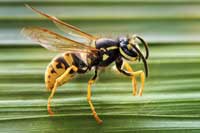
germanica)
Image courtesy of Richard
Bartz; image source:
Wikimedia Commons
The origin of kindness is a mystery. Where do giving and altruism come from? Were they inherited on the wings of natural selection – a gift bestowed upon us via the inching, evolutionary march of sacrificial amoeba, selfless penguins and charitable baboons? Or is altruism a unique refinement, a singular human triumph over ‘nature red in tooth and claw’? Charles Darwin called this the greatest single riddle, and thinkers ever since have tried to crack it.
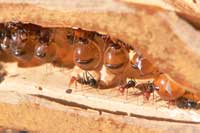
ants, some individuals have
vastly swollen abdomens,
providing a food resource for
the rest of the colony.
Image courtesy of Greg Hume;
image source: Wikimedia
Commons
Here is the mystery: if evolution is a process of survival of the fittest, and altruism is a behaviour that reduces fitness, why do we find altruistic acts wherever we look in nature? Consider the honey-pot ants of the American deserts, hanging upside down like great big pots of sugared water, perennially, waiting to be tapped by the queen and her brood when they are thirsty; or gazelles, conspicuously jumping up and down to signal to the troop that a lion lurks in the grass; or, for that matter, yellow jewelweed plants (Impatiens pallida), which, when sunlight becomes scarce, do not hog it by investing in the creation of leaves, but rather invest in stems and roots so as to share the sunlight with everyone. These are just a few of thousands of examples from across the natural world.
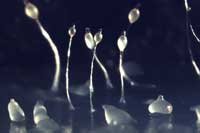
slime mould, Dictyostelium
discoideum is a soil-living
amoeba. When starved, the
normally free-living cells
aggregate into a ‘slug’,
consisting of viable spores
and an altruistic, non-
reproducing stalk.
Image courtesy of Owen Gilbert
Biological altruism is defined by the result of an action: if an amoeba acts in such a way as to reduce its own fitness while providing a fitness benefit to another, it is an altruist. (Certain species of social amoeba are known to sacrifice themselves for their brethren.) Human, or psychological altruism, on the other hand, is all about intent: if I help an old lady cross the road because I have secret designs to be written into her will, then I am not considered an altruist, even if a truck hits and kills me during the process. Still, is there a connection between altruistic acts in amoeba and altruism in humans? After all, just like the actions of the brainless miniature amoeba, the brain that allows us humans to act selflessly is a product of evolution.
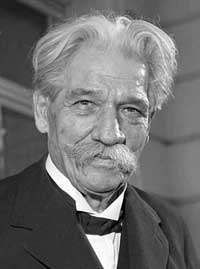
1965) won the Nobel Peace
Prize in 1952 for his
philosophy of ‘reverence for
life’.
Image courtesy of Rolf
Unterberg; image source:
Wikimedia Commons
Ever since Darwin, and really much earlier, we have sought to answer these riddles. In particular, we have been interested in whether true altruism even exists. ‘Scratch an altruist and see an egoist bleed,’ some philosophise. Is that how we should explain the lives of Nobel Peace Prize winners Albert Schweitzer and Mother Theresa? Or a soldier jumping on a grenade to save his mates? Cynics would say that, whether consciously or not, sacrifice is always driven by ulterior motives.
History teaches that when considering the relationship between nature and morality, we often stumble into what is called Hume’s Guillotine (described by the Scottish philosopher David Hume [1711–1776] and often mistakenly referred to as ‘the naturalistic fallacy’). That is, the mistake of confusing that which is with that which ought to be; or, what we observe in nature with a rule for our own behaviour (Hume, 1739). This is important when it comes to altruism, because in the years since Darwin, science has provided a number of explanations for the evolution of sacrificial traits.
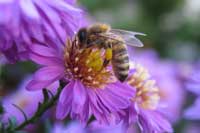
Hymenoptera) exhibit
haplodiploidy, whereby
females are more genetically
similar to their sisters than
to their own offspring. This
is thought to be a key
reason behind the evolution
of social insect colonies.
Image courtesy of CrazyD;
image source: Wikimedia
Commons
One of these explanations is nepotism: the closer the genetic relatedness, the greater the chance of altruism. This was formalised in algebra by the late British evolutionary biologist Bill Hamilton, who stated that a genetic trait for altruism should spread through a population if:
rB > C
where r is the genetic relatedness of the two individuals, B is the reproductive benefit gained by the recipient of the altruistic act, and C is the reproductive cost to the individual performing the altruistic act (Hamilton, 1964a, 1964b). Does this mean that it is natural to help kin, but unnatural to help strangers?
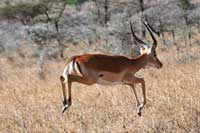
up and down to signal to the
herd that a predator is
lurking in the grass.
Image courtesy of Rick
Wilhelmsen; image source:
Wikimedia Commons
Perhaps not. Another explanation is simple reciprocation: one individual should help another in the expectation of being helped in return. Related to this is the matter of trust: if I cannot signal to others that I can be trusted, I won’t survive in a world that depends on co-operation.
A third explanation is group selection: those groups that use altruism as a social glue to help to cement cohesion will outcompete groups of non-co-operative individuals.
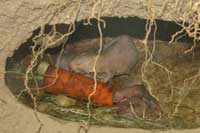
sometimes referred to as the
social insects of the mammal
world.
Image courtesy of Ltshears;
image source: Wikimedia
Commons
But do these explanations leave room for true altruism? The explanations satisfy the sceptic, as they all ultimately hinge on the logic of egotism: it’s worth helping others or even the group if it benefits yourself. And if that is what models and theories show, supported by empirical observation, then perhaps true altruism is really just a dream. More dangerous still is the idea that if we evolved to be altruistic only for selfish reasons, perhaps we shouldn’t even attempt to behave as true altruists.
One scientist who tried to solve the mystery of altruism was the US population geneticist George Price. Deriving an equation in the late 1960s that would later carry his name, Price came to believe that if altruism could be explained by mathematics, it was not true altruism. Selflessness was always interested – this is what he believed his equation seemed to indicate (Price, 1970).

such as a soldier jumping on
a grenade to save his
comrades be explained
scientifically?
Image courtesy of the UK
Ministry of Defence
For George Price, this was a terrible realisation and he descended on the homeless people of London, UK, like an angel, determined to disprove the very maths that he had constructed. In the end, having given away all his possessions, he became a homeless derelict himself, committing suicide in a cold London squat in 1975.
Science is a powerful tool for understanding the world. Neurogenetics and functional magnetic resonance imaging studies are attempting to find the genes for altruism and the particular regions of the brain that play a role in altruistic behaviour (Churchland, 2011). But precisely because of this, we need to remember the fate of George Price: his story is a personification of the very paradox of altruism. It shows that the tools of science are not always relevant to the kinds of questions we are interested in, such as how we should behave. If we are able to answer all the scientific questions we can pose, will it explain everything that we want to understand? George Price’s story demonstrates that the answer to this question is ‘no’.
Acknowledgement
This article was adapted from a previous article by Oren Harmanw1, published on the Forbes website.
References
- Churchland P (2011) Braintrust: What Neurobiology Tells Us About Morality. Princeton, NJ, USA: Princeton University Press. ISBN: 9780691137032
- Hamilton WD (1964a) The genetical evolution of social behaviour I. Journal of Theoretical Biology 7(1): 1-16. doi: 10.1016/0022-5193(64)90038-4
- Hamilton WD (1964b) The genetical evolution of social behaviour II. Journal of Theoretical Biology 7(1): 17-52. doi: 10.1016/0022-5193(64)90039-6
- Harman O (2010) The Price of Altruism: George Price and the Search for the Origins of Kindness. New York, NY, USA: W.W. Norton. ISBN: 9780393067781
- Hume D (1739) A Treatise on Human Nature. Cheapside, UK: John Noon
- The text is freely available online via Project Gutenberg.
- Price GR (1970) Selection and covariance. Nature 227: 520-521. doi: 10.1038/227520a0
- Download the article free of charge, or subscribe to Nature today.
Web References
- w1 – This article is based on an article by Oren Harman on the Forbes website.
- Also on the Forbes website, watch a video of Oren Harman discussing the story behind his latest book, The Price of Altruism.
Resources
- Philosopher Elliott Sober and biologist David Sloan Wilson attempt to reconcile altruism, both evolutionary and psychological, with the scientific discoveries that seem to portray nature as ‘red in tooth and claw’.
- Sober E, Wilson DS (1998) Unto Others: The Evolution and Psychology of Unselfish Behavior. Cambridge, MA, USA: Harvard University Press. ISBN: 978-0674930476
- To find out why psychologist Steven Pinker does not support the idea of group selection, see his essay ‘The false allure of group selection’.
Review
Altruism is a behaviour observed in all types of organism, yet its causes remain a mystery. In this article, Oren Harman explores the plausible causes of altruism and whether true altruism exists in humans.
This is not a science article in the strict sense; it could be used just as easily in a social studies lesson. Teachers could use the article as the basis of a discussion of many topics that link science and social studies subjects: for example, natural selection and altruism; the genetic basis of altruism; altruism and the fitness of the group; and mathematical formulations for altruism. The article could be used for any age group of secondary-school students, in particular those aged 15-19.
The article could be used in a comprehension exercise, with potential questions including:
- Why is altruism considered to be a behaviour that reduces fitness for the individual organism?
- Some people believe that true altruism does not exist in humans. Why is this?
- Altruism is a behaviour that could play a role in natural selection. Use a specific example to support this idea.
- ‘If altruism could be explained by mathematics, it was never really what it seemed.’ Explain what this means.
Michalis Hadjimarcou, Cyprus





